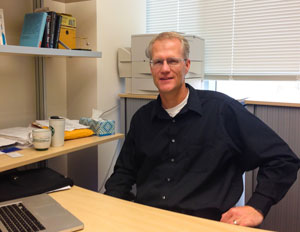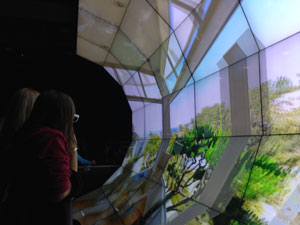Making WAVEs: a Big Data Visualization Environment
Researchers Benefit from RCI Networking and Technical Expertise
March 20, 2014
Professor Falko Kuester is passionate about creating novel research environments where local, national, and international scientists and engineers can collaborate from remote locations. An expert in visualization and virtual reality, he leads a team that recently completed an impressive prototype of a massively interconnected, high-tech display environment, called the Wide-Angle Virtual Environment, or WAVE.

Kuester is the principal investigator of the NSF Major Research Instrumentation-funded Scalable Omnipresence Environment (SCOPE) project, with co-principal investigators Tom DeFanti, Tajana Rosing and Jurgen Schulze. SCOPE offers researchers an immersive 3-D environment for remote collaboration on big data challenges. It has participants from 13 departments within UC San Diego, plus Jackson State University and the University of Texas Medical Branch.
"RCI helps to bring all the interdisciplinary talents together to collaborate on research." — Prof. Falko Kuester, WAVElab
The SCOPE project completed its first WAVE prototype in December 2013. RCI implementation partners ACT (Administrative Computing and Telecommunications) and the Qualcomm Institute (the UC San Diego division of the California Institute for Telecommunications and Information Technology, or Calit2) contributed networking and technical expertise to the project. As a result, Kuester’s work with big data researchers is empowered by a dedicated, high-speed production network. Thanks to RCI's optimization and design, network performance and bottlenecks no longer hamper their collaborations. Kuester says that RCI has helped him move a big step closer to achieving his dream:

"With the help from RCI, we are tackling new big data challenges over production networks that historically were simply out of reach."
The WAVE is fittingly located in the WAVElab of the new Structural and Materials Engineering (SME) building. It is a video wall consisting of a 5x7 array of 55-inch 3-D LCD monitors, shaped like an ocean wave. The main idea is to provide viewers with a wide, 180-degree vertical view looking straight, 90 degrees down, 90 degrees up, and close to 180 degrees horizontally. Using 3-D glasses, viewers are treated to an extremely accurate, detailed and realistic view of the subject environment.
Superior Support Benefits
To achieve its magic, the resolution of the wall requires billions of pixels to be rendered every second with datasets whose complexity is typically higher by orders of magnitude. It is unrealistic to locally replicate all the data because the sets are simply too large and difficult to synchronize. To overcome this, RCI helped to connect the WAVE to the dedicated Prism@UCSD network at 40 gigabits per second (Gbps), and to the rest of the campus at 10 Gbps. Using an adaptive and progressive algorithm, Kuester and his colleagues can dynamically render an image from the required data points without having to load an entire database. They do not need to bother cloning the data locally, nor does the WAVE require local data storage. All the data fly through the network in real time, mediated by a flash memory-based storage "cloud" called FIONA (Flash I/O Network Appliance). FIONA, the brainchild of Drs. DeFanti and Philip Papadopoulos (SDSC), is funded by the Center for Integrated Access Networks (CIAN).

"We are hoping to expand RCI networking service."
Several of Kuester’s colleagues are excited about the prospect of connecting their own instruments and databases through the Prism@UCSD network in order to make them available to their respective research communities. The effort is timely, given that ultra-high-resolution visualization and visual analytics require so much information and real-time processing that cloud-based approaches have become very desirable.
Remote Access
The WAVE is an impressive demonstration that data can be acquired, processed, and visualized dynamically in distributed environments with tight timing constraints. It's already being used with very large collections of data for research areas such as astronomy and biology, as well as archaeology and other fields of cultural heritage.
Kuester is working with his colleagues at UC San Diego to expand the WAVE’s reach by building a "Big Data Freeway." According to Drs. Papadopoulos and Larry Smarr (Calit2), the PI and co-PI of Prism@UCSD, this high-speed network will soon be upgraded to 80 Gbps. Dr. Mike Norman, PI of the NSF-funded CHERuB (Configurable, High-speed, Extensible Research Bandwidth) project, is bringing 100 Gbps connections to the campus, and FIONA can be easily scaled up in performance using the Rocks cluster software.
Big Data Enabling
Enabled by extremely fast cloud storage devices and expanded high-speed networks, Kuester and his colleagues are "making WAVEs" so that researchers and their communities are able to innovate and collaborate faster and more fluidly than ever.
 RCI News
RCI News
FIONA: innovative Big Data Network Appliance Read story...
TSCC User Meeting
View slides from
May 21, 2014
New Storage Publication
Download a new research publication on RCI Storage
 RCI Events
RCI Events
Intel Xeon Phi Programming Workshop
Intel Presents Xeon Phi developer training event at SDSC on Thursday, May 1, 2014 (see details)
TSCC Planned Maintenance March 9-10, 2014
The TSCC received a switch hardware upgrade and a Lustre upgrade on Sunday, March 9 and Monday, March 10. Read the details...